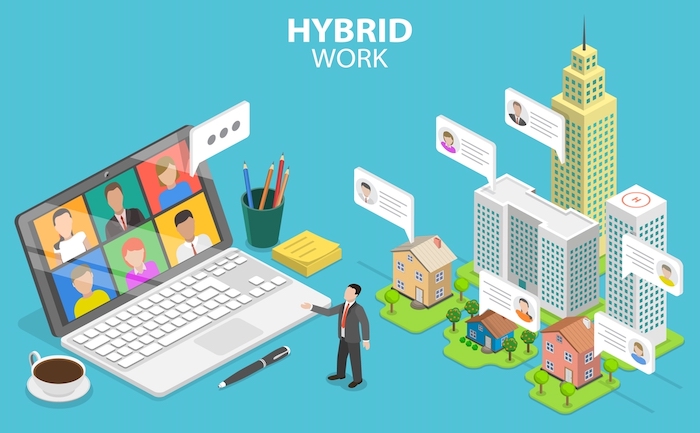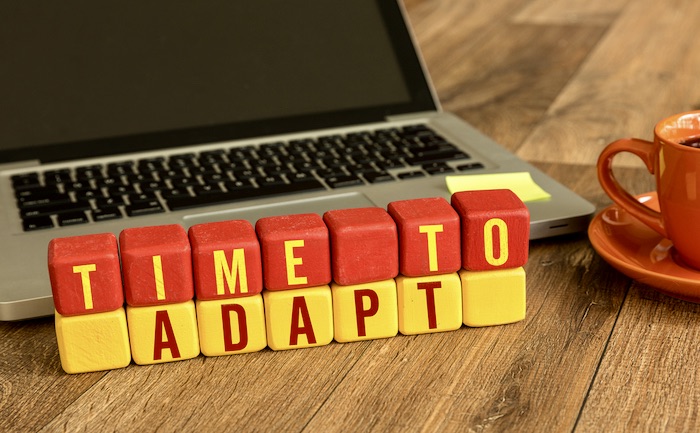
Hybrid ways of working in post-pandemic times
“Leaders are out of touch with employees and need a wake-up call.”
That’s one of the key takeaways from a study by Microsoft in March 2021. Business leaders are thriving despite the challenging conditions workers face during the pandemic.
The disparity between leadership roles and those with less authority has worsened over the past two years. This has been bolstered by societal factors that offer those in leadership roles an advantage. Most business leaders surveyed were male information workers with an established career — almost the polar opposite of those struggling the most.
Single, younger frontline workers struggle more than ever and are reaching a breaking point. Leaders need to start empathizing with their employees and seek ways to tackle the unique issues they’re facing, or they’ll start losing their workforce. That process begins with embracing hybrid ways of working.
What will work look like after the pandemic?

The modern office was designed with a focus on productivity and collaboration. It was supposed to be the perfect working environment, but that all changed in two short years. As more employees swapped workspaces for kitchen tables, many found that working from home offered the same level of productivity while improving their work/life balance.
This freedom for employees presents a challenge for management. That same Microsoft report highlights conflicting needs. 73% of workers are looking to continue flexible work practices, while 67% want to spend more in-person time with their teams.
Of course, as the way we work changes, the way we feel about work will change.
Currently, the pressure to maintain or increase productivity while working away from the office pushes employees to their limits. Meetings are longer, emails are more frequent, and with a lack of distance between their place of work and their home life, the risk of burnout is higher.
If we continue on this path, we will push employees past their breaking points and lose talent.
So, what’s the solution? How do we break the cycle before it spins into an uncontrollable disaster?
There’s no doubt that the way we work will continue to evolve, creating new challenges along the way. Leaders must quickly adapt and listen to the needs of their employees, starting with hybrid work models.
What to know about hybrid ways of working

Hybrid work models are much more than employees splitting their time between home and the office. By genuinely understanding hybrid ways of working, leaders can address key employee concerns, maintain productivity and increase employee satisfaction.
What is hybrid work?
We tend to talk about hybrid working as if it represents one way of working, but this couldn’t be further from the truth. In fact, we’re still trying to pinpoint what hybrid work actually means during these very early stages.
It currently acts as an umbrella term for many different work models, and that means that nearly every business offers up a slightly different definition.
To put it simply, “hybrid work” currently refers to a flexible work model that allows employees to work in the office and remotely. The practice started to help manage the new safety protocols required during COVID-19 but is now becoming the expected way of working for office-based roles.
Examples of hybrid work models
Until we establish a solid definition of “hybrid work,” you will find many different ways to approach hybrid working. Some models involve an equal split between remote and office working, while others allow employees to permanently switch to remote work. There is no “best” version, and it may take a little trial and error to find the correct approach for your business.
Let’s look at a few examples of how businesses have implemented hybrid ways of working.
The Citigroup Model
After a year of COVID-related chaos, Citigroup realized a typical workday during the pandemic was putting far more strain on its employees than a pre-pandemic day.
The business hit the reset button and completely overhauled its work practices, with most of Citigroup moving to a hybrid work model. Office workers would return to the office three days a week and spend the rest of their time working remotely.
Of course, not all workers can perform their positions remotely. Conversely, some can be entirely remote. Citigroup branch workers and data center employees still work in the office, while others work remotely full-time. For the sake of transparency, Citigroup renamed each role to include “hybrid,” “remote,” or “resident” to help make the transition to hybrid work easier to understand.
The Microsoft Model
As a key player in the technology sector, many look to Microsoft for guidance or inspiration when running a business. Interestingly, during the transition to hybrid work, Microsoft seems to be going with the flow rather than setting rigid guidelines straight away.
The company is constantly listening to the needs of its employees and customers and using that feedback to guide its hybrid work model. So, while guidelines allow Microsoft employees to work remotely up to 50% of the time, they can discuss with their management team and negotiate those terms.
Unsurprisingly, the tech company has emphasized remote working. They are using this unprecedented time to overhaul key business processes across the entire company, introducing automation where possible and improving remote working tools like Microsoft Teams.
The Target Model
Target’s approach to hybrid working is an example of how businesses can leverage remote working into real savings.
Target offered to make remote working permanent for corporate employees as many returned to work. While many chose to return to the office, the number of employees staying remote created an opportunity for the business.
Rather than keeping open desks and wasting office space, Target decided to shutter their Minneapolis city center headquarters. Around 3500 workers from the 51-story skyscraper would instead work remotely or transfer to a different building.
Benefits of hybrid ways of working

While many will focus on the benefits of hybrid working on employees’ work/life balance and the chance to reduce outgoings, there are many more benefits of hybrid working just waiting to be unlocked.
Few people enjoy the daily commute. It’s time-consuming, costly, stressful, and plays a part in the environmental issues our planet currently faces. One of the most significant selling points for hybrid ways of working is that it reduces the need to travel daily. Employees can save money, traffic and pollution levels will decrease, and everyone can spend more time at home.
You may have also noticed a decrease in sickness over the past couple of years. As we try our best to limit the spread of COVID, it seems like cases of the flu and the common cold are popping up less often than we would expect. Mask mandates and remote working helped many workers avoid illness over winter, with the CDC recording a tiny fraction of flu cases between September 2020 to January 2021, compared to that same period 12 months previous. This reduced level of sickness can become commonplace with hybrid working, as employees will no longer need to come into the office when they are sick.
How to incorporate hybrid working into your post-covid workflow, the right way

There’s no sugar-coating it; it will be difficult to transition to hybrid ways of working post-COVID. If it were a simple case of employees being given laptops and sent on their way, we would have made this change years ago. Successfully transitioning to hybrid work models requires a hands-on approach that adapts to regular feedback.
There isn’t a “one-size-fits-all” approach to incorporate hybrid working into your business, but there are some key considerations that will help the process run smoothly.
Find out what your employees actually want and need
All too often, senior management will make decisions that affect the entire workforce without consulting any employees. This can be fine for small things — such as changes in certain processes — but for something as significant as hybrid working, you must take your employees into consideration.
Diving headfirst into the transition could leave employees in the dark and confused about their role within the company. Your employees know what will be a good fit for them, so let them tell you what they want.
Be flexible
Hybrid work models rely on flexibility from the business and the employees. What works for one business may not work for another, which is part of the reason it’s so difficult to truly define hybrid working.
When transitioning to hybrid ways of working, businesses must continue to be flexible long after the implementation phase. We’ve seen how quickly everything can change over the past two years, and everyone should prepare for sudden changes in the future.
Trust, but verify
Switching to hybrid ways of working requires a hands-on approach with regular check-ups to ensure it remains feasible. But, you want to be a manager, not a micromanager.
It can be tempting to check in with employees regularly, but it can be time-consuming and detrimental to productivity. Trust your team to work under their own steam because they are likely doing their job in the same way they would at the office.
If issues crop up, you can speak directly to your employees and reassess if they need further support or if hybrid working isn’t for them.
Invest in the right technology

The pandemic has forced tech companies to step up in an unprecedented way. Companies such as Zoom, Microsoft, and Slack have enjoyed a sharp upswing in users and have spent the last couple of years perfecting their remote work solutions.
Communication technology is crucial to hybrid working, but as we improve the resources we use for remote working, we should also look at how these resources can improve the office.
Workplace scheduling solutions such as Smartway2 offer businesses a simple way to manage their offices. As hybrid work models take hold, companies can use a platform like Smartway2 to optimize their office space with hot-desking, meeting room scheduling, and the opportunity to rent out unused space to external workers.
Request a demo to see how Smartway2 can offer an easy way to embrace the hybrid future.


